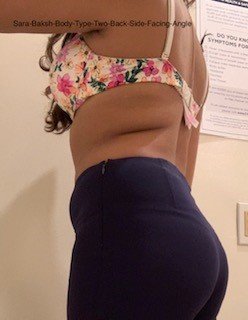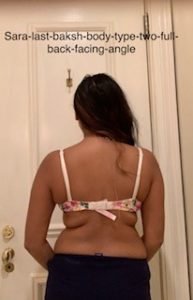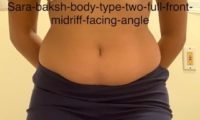FORCA?Fellow One Research Combined Average (FORCA) Health Score which Averages the Self-Determined (SD) Health & FORC Health Scores [5 is Very Healthy, 1 is Very Unhealthy]. This score is in beta testing.
2.89
FORTH?Fellow One Research Total Health (FORTH) Score [5 is Very Healthy, 1 is Very Unhealthy]. This score is in beta testing.
3.42
FORMR?Fellow One Research Metabolism Rate (FORMR) Adjusted Mifflin St Jeor Equation BMR (Basal Metabolic Rate) Score. This score is in beta testing.
Normal Metabolism
Mifflin St Jeor BMR: 1267.08
Adjusted Mifflin St Jeor: 1246.81
FORMA?Fellow One Research Metabolism Activity (FORMA) Adjusted Harris-Benedict Equation Activity Score. This score is in beta testing.
Steady Metabolic Rate
Body Mass Index (BMI) Calculation
23.8
BMI Minimal, Moderate, High Risk
Minimal Risk

Fellow One Research Participant Sara Baksh Bio Summary – Body Type Two (BT2)
I have studied The Four Body Types and I believe I am a Body Type Two (BT2). Obesity has moderately been a problem in my life. My obesity problems started in my life between age 16 and age 19. I was at my heaviest weight when I reached 131 pounds at age 21. The most weight I ever lost was 6 pounds when I was 23. I have been successful at keeping all that weight off to date. I gained back 0 of those pounds in a span of 0 month(s). I have not experienced the obesity weight gain & loss management roller coaster ride, it has not been severe.
If/when I put fat weight on my body, it is most likely that I will put the fat weight on in relation to: lower midriff/waist/hips, midriff/abdomen/belly, lower side trunk/love handles, face, as accurately as I can figure.
Upon careful examination of my spine, vertebra(e) (posture), and muscle/muscle mass, I am confident that the following vertebra(e) in my body are underdeveloped if not undeveloped: thoracic 5, thoracic 6, thoracic 7, thoracic 11, thoracic 12, lumbar 2, lumbar 3, as best I can surmise. I am quite sure my body does not look identical to a Body Type One (BT1) with all muscles developed & defined. My body has not always had the fully developed BT1 classic arch, dimples, vertebrae (posture), and muscle mass. I am certain I do not have the fully developed BT1 classic arch and dimples, which strengthens my belief I'm not a BT1.
| Fellow One Research Identifies this ‘The Four Body Types’ Research Participant’s Body Type as a: |
| Basic Self-Determined Research Participant Health Score (5 is Very Healthy, 1 is Very Unhealthy) |
| Basic Calculated Fellow One Research Participant Health Score (5 is Very Healthy, 1 is Very Unhealthy) |
What Does My Body Type Two (BT2) Mean?
Life is all about balance. Unbalance allows a human being to truly understand balance by recognizing, honestly, what their unbalances truly are. All be it some more than others, all human beings are unbalanced physically, mentally, emotionally, and spiritually, at least to some extent. But most human beings are very unbalanced and unhealthy. The more unbalanced the body type (BT4 is the most unbalanced body type), the more physical work the specific individual person has to do to bring their human body into a state of true physical balance (BT1).
Body Type One (BT1): Physically balanced (Anatomy Standard).
| *Fully developed vertebrae, spinal extension (posture), and muscle. *33 out of 33 Vertebrae Developed and Extended, relative to the 24 Moveable & Two Fixed Bones (0 Vertebrae Undeveloped/Underdeveloped) *Very Low to Low probabilities of experiencing obesity in the short and long-terms. *High tendencies to be symmetrical and attractive. *Mental (mind), emotional (energy in motion), and spiritual (soul/soul energy/star power/IT Factor) balance matters equally as much as physical (body/genetics/DNA) balance. |
Body Type Two (BT2): Less Physically Balanced.
| *Mostly developed vertebrae, spinal extension (posture), and muscle. *32 to 22 out of 33 Vertebrae Developed and Extended, relative to the 24 Moveable & Two Fixed Bones (1-8 Vertebrae Undeveloped/Underdeveloped) *Low to Medium probabilities of experiencing obesity in the short and long-terms. *Moderate tendencies to be symmetrical and attractive. *Mental (mind), emotional (energy in motion), and spiritual (soul/soul energy/star power/IT Factor) balance matters equally as much if not more (to make up for physical unbalances) while the BT2 person is achieving to physical (body/genes/DNA) balance. |
Body Type Three (BT3): More Physically Unbalanced.
| *Moderate to mostly undeveloped vertebrae, spinal extension (posture), and muscle. *21 to 11 out of 33 Vertebrae Developed and Extended, relative to the 24 Moveable & Two Fixed Bones (9-17 Vertebrae Undeveloped/Underdeveloped) *Medium to High probabilities of experiencing obesity in the short and long-terms. *Moderate tendencies to be asymmetrical and unattractive. *Mental (mind), emotional (energy in motion), and spiritual (soul/soul energy/star power/IT Factor) balance matters even more (to make up for physical unbalances) while the BT3 person is achieving to physical (body/genetics/DNA) balance. |
Body Type Four (BT4): Mostly to Fully Physically Unbalanced.
| *Mostly to completely undeveloped vertebrae, spinal extension (posture), and muscle. *10 to 0 out of 33 Vertebrae Developed and Extended, relative to the 24 Moveable & Two Fixed Bones (18-26 Vertebrae Undeveloped/Underdeveloped) *High to Very High probabilities of experiencing obesity in the short and long-terms. *High tendencies to be asymmetrical and unattractive. *Mental (mind), emotional (energy in motion), and spiritual (soul/soul energy/star power/IT Factor) balance matters even that much more (to make up for physical unbalances) while the BT4 person is achieving to physical (body/genes/DNA) balance. |
More Fellow One Research Participant Data – Sara Baksh & Skinny Fat, Back Pain, Diet, Exercise, Lifestyle
Skinny Fat & Back Pain

Skinny fat has not ever been a serious problem in my life. I never experienced the skinny fat phenomenon in the past and/but I am not experiencing the skinny fat phenomenon in my life at present. After reviewing my body, I am experiencing and/or have experienced skinny fat relative to: nowhere as far as I can tell.
On average, I experience back aches and pain. I feel back aches and pains in my body in relation to: cervical 7, thoracic 1, thoracic 2, thoracic 3, and it is directly relative to my Body Type Two (BT2).
Diet (Food & Drink/Hydration)
| Basic Self-Determined Research Participant Diet Score (5 is Very Healthy, 1 is Very Unhealthy) |
| Basic Calculated Fellow One Research Participant Diet Score (5 is Very Healthy, 1 is Very Unhealthy) |
My daily diet is questionably healthy overall. I would say my diet is evenly mixed omnivore. I eat a fair mix of whole organic and regular food. I drink alcohol a few times per week, following the recommended 1 glass/day women/2 per day men. I drink no more than the equivalent of 4, 8 ounce glasses of clean water daily and I am dehydrated.
Cardio & Resistance (Weight Lifting, Calisthenics (Body Weight), Isometrics/Gravity) Exercise Training
| Basic Self-Determined Research Participant Exercise Score (5 is Very Healthy, 1 is Very Unhealthy) |
| Basic Calculated Fellow One Research Participant Exercise Score (5 is Very Healthy, 1 is Very Unhealthy) |
 My weekly cardio exercise training routine is unhealthy. I do cardio exercise 5x per week. My training is 15 minutes per day. I like the following types of cardio activities: walking and the like.
My weekly cardio exercise training routine is unhealthy. I do cardio exercise 5x per week. My training is 15 minutes per day. I like the following types of cardio activities: walking and the like.
My weekly resistance exercise training routine is very unhealthy. I do not do any resistance exercise; 0x per week. I enjoy the following kinds of resistance exercise training activities: nothing as it stands now.
Lifestyle (Career, Relationships, Travel, Hobbies, Sleep, etc.)
| Basic Self-Determined Research Participant Lifestyle Score (5 is Very Healthy, 1 is Very Unhealthy) |
| Basic Calculated Fellow One Research Participant LifestyleScore (5 is Very Healthy, 1 is Very Unhealthy) |
My lifestyle overall is questionably healthy. I get 5.0 to 6.0 hours of sleep per day/night on average. My daily/nightly sleep, on average, is of questionable quality as I can toss & turn, awaking refreshed slightly to moderately each morning. I find I am happiest when I partake in the following lifestyle activities: career/job/work, family relationships, intimate/romantic relationship(s), platonic relationships-friendships, professional/business relationships, pet relationships, entertainment outlets, financial opportunities, and such.
Fellow One Research Participant, The Four Body Types’ Free Body Type Shape Quiz Calculator – One Question I Would Like Answered:How Important is Diet, Exercise, and Lifestyle in terms of my Body Type and Health? |







